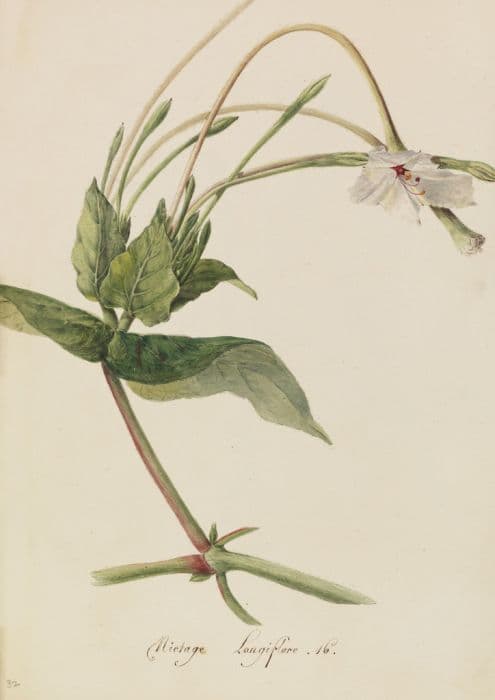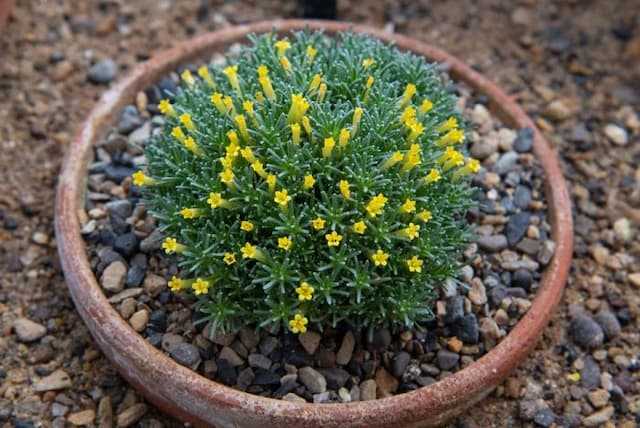Long Flowered Tobacco Nicotiana longiflora

ABOUT
Nicotiana longiflora, commonly known as long-flowered tobacco, is a species of plant that is notable for its dramatic and attractive blossoms. The appearance of this plant is characterized by large, tubular flowers that are particularly elongated, hence the name "longiflora." These flowers are usually white and give off a sweet, intense fragrance, especially in the evening. The plant has a lush arrangement of leaves, which are typically broad, pointed, and a deep green in color, providing a verdant backdrop to the striking flowers. The overall shape of the plant is somewhat bushy, with a well-branched structure that supports the weight of the blooms. The blooms themselves are arranged in loose clusters at the tips of the branches, creating a visually appealing display. Despite avoiding the mention of precise measurements, the long-flowered tobacco is recognized for having a significant floral presence.
About this plant
 Names
NamesFamily
Solanaceae
Synonyms
Longflower Tobacco, Sweet Tobacco
Common names
Nicotiana affinis, Nicotiana fragrans, Nicotiana longiflora var. plena, Nicotiana longiflora var. splendida.
 Toxicity
ToxicityTo humans
Nicotiana longiflora, commonly known as longflower tobacco, contains nicotine and other alkaloids that can be toxic to humans when ingested. Symptoms of poisoning can include nausea, vomiting, headache, dizziness, sweating, and increased salivation. In severe cases, it can lead to more serious symptoms such as tremors, convulsions, or cardiac arrest. The ingestion of any part of the longflower tobacco plant, especially in large quantities, can have serious health consequences and should be avoided.
To pets
Longflower tobacco is also toxic to pets due to the presence of nicotine and other alkaloids. If a pet ingests any part of the plant, they can show symptoms such as vomiting, diarrhea, drooling, decreased appetite, abdominal pain, lethargy, tremors, and possibly seizures. In severe cases, ingestion can result in death. Immediate veterinary care is recommended if a pet is suspected of ingesting longflower tobacco.
 Characteristics
CharacteristicsLife cycle
Perennials
Foliage type
Deciduous
Color of leaves
Green
Flower color
White
Height
3 feet [0.91 meters]
Spread
1 feet [0.3 meters]
Plant type
Herb
Hardiness zones
10
Native area
Argentina
Benefits
 General Benefits
General Benefits- Ornamental Value: Nicotiana longiflora, commonly known as long-flowered tobacco, is often grown for its elongated, trumpet-shaped white flowers that add aesthetic value to gardens.
- Attracts Pollinators: The plant's flowers produce a sweet fragrance that attracts beneficial insects like bees, butterflies, and hummingbirds, aiding in pollination.
- Night Blooming: Long-flowered tobacco blooms primarily at night, providing a unique visual and olfactory experience in evening gardens.
- Low Maintenance: Once established, Nicotiana longiflora requires minimal care, making it suitable for gardeners of all levels.
- Drought Tolerance: The plant is relatively drought-tolerant, which allows it to thrive in drier climates with less water.
- Companion Planting: It can be used in companion planting to attract pollinators for other nearby plants in a garden ecosystem.
 Medical Properties
Medical PropertiesThis plant is not used for medical purposes.
 Air-purifying Qualities
Air-purifying QualitiesThis plant is not specifically known for air purifying qualities.
 Other Uses
Other Uses- Nicotiana longiflora, known as long-flowered tobacco, can be used as an ornamental plant in gardens for its attractive, long, tubular, white flowers which bloom at night and release a pleasant fragrance.
- The plant has been used in traditional ceremonies and rituals by indigenous peoples in South America due to its cultural significance and the belief in its ability to ward off evil spirits.
- Its strong scent makes it a natural choice for creating perfumes and scented products, often capturing the essence of a summer evening.
- Long-flowered tobacco can be employed as a companion plant due to its ability to attract beneficial pollinators such as moths and hummingbirds to the garden.
- The plant's leaves have been used as a natural insect repellent in agricultural practices to protect other crops from pests.
- Nicotiana longiflora can be part of educational projects and botany studies, helping students learn about plant biology, pollination, and the evolution of plant-pollinator relationships.
- The dried leaves of long-flowered tobacco may be used in crafting botanical paper or creating natural dyes for textiles, given their various compounds and pigmentation.
- Its seeds, like those of many Nicotiana species, are harvested for propagation purposes, contributing to botanical diversity and horticultural exchanges.
- In areas where it is native, the plant can play a role in land reclamation and habitat restoration, helping to stabilize soil and provide cover for wildlife.
- Its robust nature and adaptability to different environmental conditions make it an ideal candidate for study in plant resilience and climate change research.
Interesting Facts
 Feng Shui
Feng ShuiThe plant Nicotiana longiflora, commonly known as Jasmine Tobacco, is not used in Feng Shui practice.
 Zodiac Sign Compitability
Zodiac Sign CompitabilityJasmine Tobacco is not used in astrology practice.
 Plant Symbolism
Plant Symbolism- Attractiveness: The trumpet-shaped flowers and the plant's fragrance make it appealing to both humans and moths, symbolizing an innate attractiveness or allure.
- Mystery: Nicotiana longiflora blooms at night, which has led to its association with the mystical and the unknown, as it reveals its beauty in the darkness.
- Healing: Historically used by indigenous peoples for medicinal purposes, it represents a connection to healing and traditional remedies.
- Temptation: As a member of the tobacco family, it can be symbolic of temptation and the potential for addiction or unhealthy habits.
 Water
WaterThe most common common name for Nicotiana longiflora is Jasmine Tobacco. It should be watered regularly to keep the soil evenly moist but not soggy. During the active growing season in spring and summer, water Jasmine Tobacco when the top inch of soil feels dry, typically once every 2 or 3 days, but this can vary based on temperature and humidity. In terms of amount, approximately half a gallon per week for a medium-sized plant is sufficient. Cut back on watering in the fall and winter months to prevent overwatering as growth slows.
 Light
LightJasmine Tobacco thrives in full sun to partial shade, with at least six hours of direct sunlight a day being ideal. The best spot for this plant would be where it can receive ample morning sunlight while being shielded from the harshest afternoon rays, especially in hot climates.
 Temperature
TemperatureJasmine Tobacco prefers warm conditions and does well in temperatures between 60 and 75 degrees Fahrenheit. It should not be exposed to temperatures below 50 degrees Fahrenheit to avoid cold damage. The ideal temperature range for vigorous growth is right in the middle of its tolerance levels.
 Pruning
PruningPruning Jasmine Tobacco is primarily done to encourage fuller growth and maintain an attractive shape. Pinch off the tips of young plants to promote branching. Deadheading spent flowers can also stimulate new blooms. The best time to prune heavily is in late winter or early spring, before new growth begins.
 Cleaning
CleaningAs needed
 Soil
SoilThe ideal soil mix for long-flowered tobacco should be fertile, well-draining, with a high content of organic matter. The soil pH should range between 6.0 and 7.0.
 Repotting
RepottingLong-flowered tobacco should be repotted annually, as it benefits from fresh soil and space to accommodate its growing root system.
 Humidity & Misting
Humidity & MistingLong-flowered tobacco thrives in moderate humidity levels; aim for humidity around 40-60% for optimal plant health.
 Suitable locations
Suitable locationsIndoor
Place long-flowered tobacco in well-lit area, away from drafts, and keep soil moist.
Outdoor
Plant long-flowered tobacco in sun to partial shade and protect from strong winds.
Hardiness zone
9-11 USDA.
 Life cycle
Life cycleNicotiana longiflora, commonly known as Long-Flowered Tobacco, begins its life cycle when its seeds germinate in warm, moist soil. The seedlings grow into leafy plants with a robust root system, and as they mature, they form a rosette of large, sticky, green leaves. The plant then develops a tall stem which produces tubular, fragrant white flowers that open at night, attracting pollinators such as moths. After pollination, these flowers develop into capsules containing numerous tiny seeds. Once mature, the seed capsules split open, dispersing seeds that can give rise to new plants. This cycle can occur multiple times in a year depending on growing conditions.
 Propogation
PropogationPropogation time
Spring to summer
Nicotiana longiflora, commonly known as long-flowered tobacco, is typically propagated through seeds. The most popular method involves sowing the seeds indoors about 6 to 8 weeks before the last expected frost. Fill a container with a well-draining seed starting mix, sprinkle the tiny seeds on the surface, and lightly press them into the soil without covering them, as they need light to germinate. Keep the soil consistently moist by misting it lightly with water, maintaining a temperature around 70°F (approximately 21°C). Seedlings usually emerge within 10 to 14 days and can be transplanted outdoors once the danger of frost has passed and seedlings have grown strong enough. Thin them to stand about 12 to 18 inches apart (30 to 45 centimeters) to allow ample space for growth.

![Petchoa [Beautiful Cinnamon]](/_next/image?url=https%3A%2F%2Fplants-admin.emdemapps.com%2Fimages%2Fplants%2F%2Fimages%2F604b56f650ada.png&w=640&q=75)
![Petunia [Black Night]](/_next/image?url=https%3A%2F%2Fplants-admin.emdemapps.com%2Fimages%2Fplants%2F%2Fimages%2F604b55ec59fcb.png&w=640&q=75)

![Petunia [Surfinia Purple]](/_next/image?url=https%3A%2F%2Fplants-admin.emdemapps.com%2Fimages%2Fplants%2F%2Fimages%2F604b5c61be5c8.png&w=640&q=75)



![Calibrachoa [Cabaret Sky Blue]](/_next/image?url=https%3A%2F%2Fplants-admin.emdemapps.com%2Fimages%2Fplants%2F%2Fimages%2F604b5fcd96809.png&w=640&q=75)
![Calibrachoa [Caloha Double Peach]](/_next/image?url=https%3A%2F%2Fplants-admin.emdemapps.com%2Fimages%2Fplants%2F%2Fimages%2F604b63d40ceae.png&w=640&q=75)